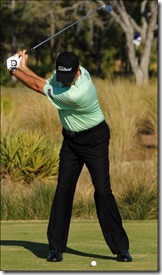How do professionals get the distance they do? Key Elements of a professional golf swing
How do professionals get the distance they do? The short answer is – ‘By Winding up the big muscles (coiling)’. This post will describe what it is that professional golfers manage to do better than amateurs (it isn’t really that intimidating).
When you coil your left side (around a steady spine), you generate a sizable torque. Unwinding this giant torque generates tremendous speed – which is the key factor in ‘hitting it long’. That part is easy to understand. Figuring out exactly how to accomplish this coil has a few components – I will try and distill the most important ones.
How does the spine stay so steady?
The bottom-line is that without a constant spine angle, you will lose your coil. The spine is the axis around which the body winds up – dislodge the axis – and you dislodge your windup. There are a few other ways to lose your coil (hip slide, head bobbing). However, if you can maintain your spine angle, you should be able to produce a coil similar to the pros.
If you are unable to maintain your spine angle during the backswing, try one of these earlier posts :
- Create a GAP on your backswing
- Use your COLLARBONE angle to dictate spine angle
What are the hands doing ?
The upper body muscles are busy WINDING up – what exactly are the hands doing during this time?
To correctly wind up your body around your spine, your hands need to form ONE unit. This can be accomplished by a slight ‘right side’ movement during the start of the takeaway. I like to imagine my right arm sliding down the shaft. What this does is two things :
- It ALIGN the forearms. This may sound trivial but is absolutely key to keeping the arms passive as the body executes its turn.
- It also opens up the right shoulder allowing the right side of the body to become passive (simply go along for the ride – as the left side coils around the spine).
If this ‘sliding of the right arm’ sounds confusing, I recommend trying this product (the website and marketing may be cheesy, but there is a lot of merit to the product). Essentially, this swing trainer provides correct hand (and right arm) action during the start of the swing. This is an area a lot of amateurs struggle with – and it isn’t always possible even for a trained coach to spot this error.
Once you get used to this ‘sliding’ action of the right arm, you will discover that your hands (and forearm) form a SINGLE unit. This is a great precursor to the WINDING motion.
In fact, without this BINDING of the forearms, the arms and hands tend to flail all over the place – as you turn back. In other words, while your coiling action may be flawless, your hands will twist and turn the club in an incorrect manner. The hands need to stay aligned and passive on the way back – just ‘going along for the ride’- while the left side does its job of winding up. In fact, the only time the hands get actively involved in the entire swing is when they reach hip height (during the downswing). See this post for more on this ‘punching’ action of the hands.
The Setup – A grip and posture that encourages the WIND UP
While there are a lot of details about correct posture and grip (and people HAVE written entire books on these subjects), I would emphasize two setup cues above all others.
- Shaking Hands with the club (Grip)
- Equal Weight Distribution (Posture)
Shaking Hands With the Club (Grip) : Your hands were designed to be placed at a 45 degree angle (think of a motorcycle or a bike handle). Almost every good golfer places her hands on the golf club in the same way. Coaches describe this in many different ways . Sam Snead used to imagine he was sliding his hand into a gun holster. My golf coach used to say – your hands should point to 7 O clock (with 6 O Clock pointing straight to the ball). All these are ways of saying the same thing – You need to shake hands with the club – especially with your left hand.
Equal Weight Distribution (Posture) : This can mean lots of different things. Most people refer to the weight distribution between the FRONT and the BACK. While this may be true, on this point, it is sufficient if your weight falls somewhere between your toes and heel (i.e. should NOT fall completely on the toes). What is more subtle is the equal ‘Left and Right’ Weight distribution. This is crucial to initiate a good coil around a central axis (the spine). There are many ways to accomplish this – the simplest is to start out with your left shoulder a LITTLE lower than your right (when you place your RIGHT hand on the club, your RIGHT shoulder will automatically go lower). This way, your (lowered) left shoulder will act as a counterweight to the right shoulder – and you should be able to feel an equal weight between your left and right side.
These two setup cues should take care of most of the postural prerequisites for executing a decent coil.
SUMMARY
While the exact nature of their swings may differ, all pro swings do have a few things in common. A constant spine angle (against which to coil), passive hands that work as a SINGLE unit – and that take on life only during the latter part of the downswing – and a setup that encourages all of the above.

Leave a Reply